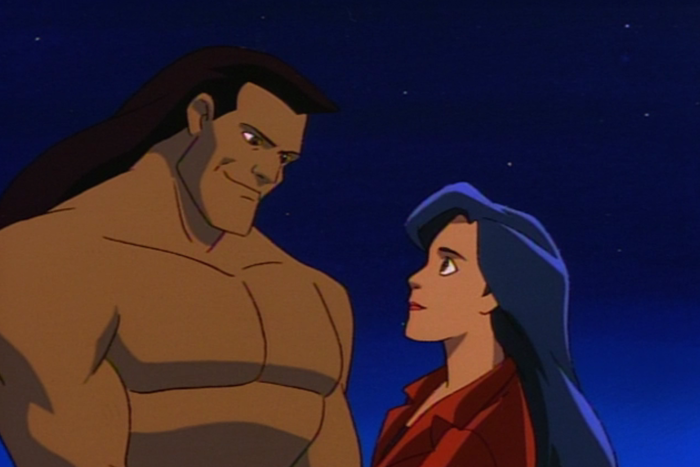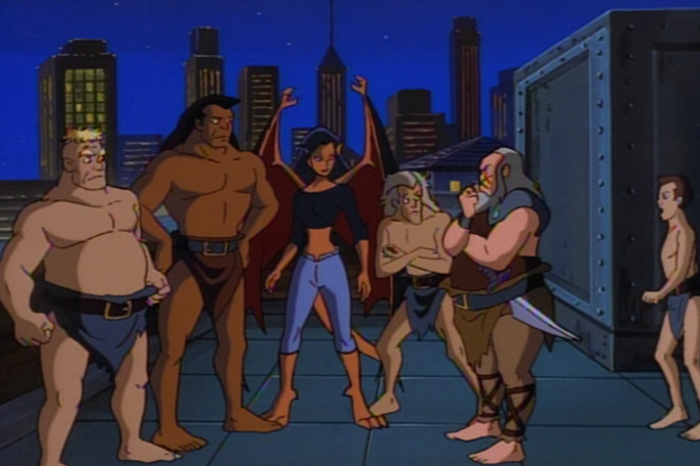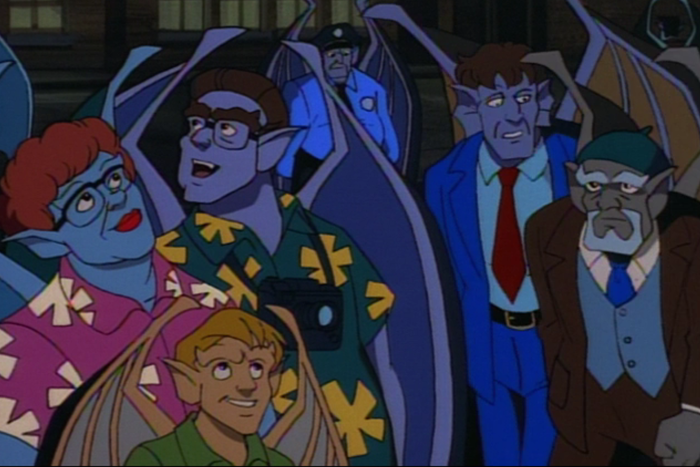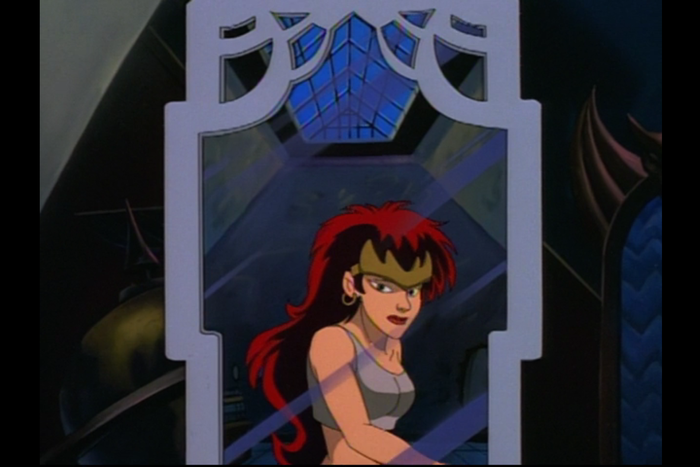
If you were a ’90s latchkey kid who watched Disney Television Animation’s afternoon programming block, your daily rotation was heavy on high jinks. DuckTales and The Lion King’s Timon & Pumbaa, Mighty Ducks, 100 Dalmatians: The Series, Aladdin: The Series, and Hercules: The Animated Series — all were full of recognizable characters with pleasantly digestible narratives. So it was a delight for weirdos like me that the dramatically goth, poignantly melancholy, and complexly plotted Gargoyles, one of the rare original offerings in the Disney Afternoon lineup, was nothing like its peers, especially when putting its own spin on a classic “be careful what you wish for” story in season two’s series-defining “The Mirror.”
Gargoyles was intended to be Disney’s rival to Batman: The Animated Series, a critical and commercial hit for Warner Bros. Animation. But where that show to some degree relied on decades of established story lines involving our favorite brooding detective, Bruce Wayne, Gargoyles’s creative team was building something from scratch and making it simultaneously macabre and sincere. The animated series followed a group of gargoyles known as the Manhattan Clan who, despite their loyalty to humans, endured prejudice and disdain from them 1,000 years ago. They wake up in modern-day New York City, shocked by how much has changed. Led by Goliath (Keith David), they become allies with biracial human cop Elisa Maza (Salli Richardson-Whitfield), butt heads with villains like Goliath’s gargoyle ex Demona (Marina Sirtis), and struggle to find their place in this new world.
Thematically, Gargoyles felt a lot like fellow formative millennial text X-Men: The Animated Series, with the gargoyles experiencing, both in the past and the present, cruelty from the human majority and an acute sense of their own isolation; they long for the days when more gargoyles existed and the clan didn’t feel so alone. Its gothness, though, put Gargoyles in its own category of kids’ programming. Seemingly monstrous, actually noble creatures who only come to life at night: check. A forbidden romance between Goliath and Elisa, who come from different worlds: check. Art design and animation sequences that emphasized the gargoyles’ fangs and claws, and how they wear shadow and moonlight like clothing (in addition to their, uh, skimpy loincloths): check. Artist Greg Guler, who created the initial concepts for Goliath, his grizzled mentor Hudson (Ed Asner), Demona, and Elisa, recalls during his first meeting with series co-creator Greg Weisman that the “only inspiration” he was given was the demonic entity Chernabog from Fantasia. (Early character-design ideas for the gargoyles featured feathered and pterodactyl-style wings, and Guler experimented with Goliath as a “dragon man” with a crest rather than hair and spiky protrusions running down his forearms.) Guler says he recalls the series provoking a certain wariness from Disney. “If you look at their original, first stuff that they put out advertising this show, Disney’s name isn’t even on it — it’s Buena Vista Productions — because they were so nervous,” Guler says. “They sent stuff to Comic-Con; I remember there being a big statue of Goliath in the middle of the floor with nothing around him. They just didn’t know how to handle it.”
But what appealed about Gargoyles — and what is particularly clear in “The Mirror” — is the series’ guiding idea that our concepts of monstrosity and humanity are all based on perspective. For any lonely kid watching (me) who was bullied for being different (also me), Gargoyles’s insistence that the Manhattan Clan experienced the same desire for friendship, love, and recognition as “normal” humans, and deserved those things, felt radical. Diving into those themes with regularity and depth was the series’ intention from the beginning, says Weisman. He left his position as Disney Television Animation’s director of series development after pitching Gargoyles with a team of collaborators, and served as the series’ supervising producer and supervising story editor for its first two seasons. (The series had significant creative turnover between its second and third seasons, when it switched from a weekday-afternoon syndication spot to Saturday mornings on ABC; Weisman and most fans don’t regard the third season as canonical.) Of the series’ guiding theme, Weisman says, “We’re hardwired for tribalism. Way back when, way back when, maybe that made sense as a survival thing. But now it’s getting in our way, hugely.”
“The Mirror” is the series’ most imaginative articulation of this idea, and its most bittersweet request for its audience to go through life with compassion instead of scorn. In the episode, the Manhattan Clan becomes human and Elisa and the rest of New York become gargoyles, but the humans turned gargoyles still treat the gargoyles turned humans with fear and suspicion. Demona steals a magical mirror — which resembles an Art Deco–style guillotine, and which Weisman has described as a “a window, a doorway, a Peeping Tom” — and casts a spell that summons Puck (Brent Spiner), the sprite made infamous by Shakespeare’s A Midsummer Night’s Dream. Puck immediately senses that Demona still longs for her ex-lover Goliath. When she orders him to cast a spell that would “rid me of that human, Elisa Maza,” the trickster turns Elisa into a gargoyle with a spell that makes her believe she’s always been a gargoyle and that the gargoyles have always not been. As Goliath, Hudson, and their teen-gargoyle comrades Lexington (Thom Adcox-Hernandez), Broadway (Bill Fagerbakke), and Brooklyn (Jeff Bennett) work to get their hands on the mirror, Puck keeps purposefully misinterpreting Demona’s wishes, next using the World Trade Center to amplify his spell and turn the rest of Manhattan’s humans into gargoyles and the Manhattan Clan into humans.
The species swap was Weisman’s idea, but he insists “The Mirror” was a team effort between himself and the episode’s writer Lydia C. Marano, story editor Brynne Chandler Reeves, and director Frank Paur, who was also Weisman’s creative partner and fellow producer. In 2000, on a Gargoyles fan site where Weisman has a recurring feature called “Ask Greg,” he shared the original memo he sent to Marano and Chandler Reeves about their first draft, follow-up feedback he sent to Chandler Reeves after she and Marano turned in a second version, and his own thoughts after rewatching the episode years later. Among Weisman’s requested changes: Cut a scene where the gargoyles get hot dogs, add more moments between Elisa and Goliath that emphasize their romantic bond, and keep the transformations low-key. Weisman had to fight for the latter, he says. “My theory [was] that the way the episode would work best is when each character or group of characters was transformed, they didn’t realize they had been transformed. They just felt how they were relative to the quote-unquote other,” says Weisman. “My partner, Frank Paur, and the executives overlooking it, they were like, ‘This is too complicated. The kids won’t get it.’” He countered by promising the transformation would be the only part of the episode that wasn’t complicated. It would be what makes “everything clear.”
Weisman was right: “The Mirror” moves more briskly without showing New Yorkers freaking out about suddenly having wings, intense muscle definition, and no shoes. Viewers can just enjoy the absurdism of newly turned gargoyles going about their lives dressed as tourists, stylish teenagers, and Wall Street businessmen. (“Somehow their clothes magically changed, too, for them, which is very convenient,” says Guler with a laugh.) The episode hits a note of gloominess, too, as we see how out of time the gargoyles-as-humans are as they run around Manhattan in their loincloths, wielding ancient weapons and shying away from pretty girls who catch their eye on the subway. In third act of “The Mirror,” the gargoyles force Puck to revert everyone back to their original species, and Demona breaks the mirror — a scene that accidentally didn’t get animated, Weisman says, which is why there’s a smashed-glass sound-effect fix in the episode’s final seconds. (Puck also curses Demona with a human-by-daylight form, unbeknownst to the gargoyles, a major turning point for the rest of the series.) Earlier in the episode, the gargoyles had fantasized about being shape-shifters with the ability to “fit in anywhere” and “find new friends, maybe even love” — and “The Mirror” ends with that longing still in place, especially between star-crossed lovers Goliath and Elisa.
Like true goth-romance icons, Elisa and Goliath spend “The Mirror” realizing that they’ve already fallen for each other, and that their reality doesn’t allow for that love. At first, the episode packs in meet-cutes and enough light flirting to communicate that the two are “clearly vibing on each other,” Weisman says. Elisa breaks into a gigantic smile when she transforms into a gargoyle and throws her arms around Goliath, overjoyed to see him. Goliath tells Elisa she’s beautiful and, when she jokingly asks if he thought she was ugly as a human, turns flustered and changes the subject by pretending there’s an updraft affecting their flight over the city. “Keith’s reading on that is brilliant, and so is Salli’s reading of Elisa as sort of semi-accusatory,” Weisman says. “But now that genie is out of the bottle, and he can’t put it back in. He doesn’t want to put it back in.” After gargoyle-Elisa saves human-Goliath from falling to his death, Goliath tries to talk about how he feels — and Elisa, unable to imagine a future together without magic or other surreal tampering, won’t do it. Goliath turns to stone for the day and she walks away, saying, “That’s the way it is.” It’s a heartbreaking end to a romance that seemed to finally be blooming. It’s also exactly what Weisman wanted; as he said to Marano and Chandler Reeves in his memo about their first draft: “Get it so that we can all almost taste it. Then yank it away. (I know, I’m a cruel bastard.)”
The characters’ species swap was divided between the series’ artists and animation staff, Guler says. As season two’s lead character designer, Guler was responsible for Elisa’s transformation into a gargoyle and Demona’s transformation into a human — bulking up the former and slimming down the latter — and collaborated with Paur on Puck’s look. It was important to the series’ creative team that the gargoyles’ human versions resemble their voice actors as much as possible, so the bald Lexington got a brunette buzz cut to look more like Adcox-Hernandez, while Fagerbakke and Bennett “influenced” Broadway and Brooklyn’s body shapes and hairstyles, Weisman says. Most dramatic was Goliath’s transformation, in which his skin tone changes from purple to brown, a deliberate choice to align Goliath both with David, his voice actor, and Elisa, his love interest. “Subconsciously this desire to be closer with Elisa, less othered from Elisa, may have affected that in universe. He was feeling romantically more engaged with Elisa than he ever had before,” Weisman says of Goliath. “Out of universe, it’s like, I don’t need gargoyles to be default white. We had a handful of white actors playing some of the gargoyles and a handful of actors of color playing some of the other gargoyles. Why should Goliath be white?”
Elisa and Goliath finally kiss at the end of season two, which Guler thinks helped expand the series’ audience. “It was funny because we did a Comic-Con in San Diego, and we were all up there. I was sitting next to Keith David, the rest of the cast is there. We expected kids. But it was moms!” Guler laughs. “I’m looking out there, it’s all these moms, and Keith David turns to me and goes, ‘What’s going on with all these moms?’ And I said, ‘They’re here for you, buddy!’” In recent years, the Elisa/Goliath romance has become a major component in Weisman’s Gargoyles comics, where he’s continued their story. “They haven’t figured everything out about how this is going to work, but they are a committed romantic couple,” Weisman says. “And none of that happens unless you go all the way back to ‘The Mirror.’”
Looking back, neither Weisman nor Guler remembers thinking of the series as goth. Weisman uses “edgy” and “neo-punk” in describing Gargoyles’s ’90s-influenced aesthetic and says in a wonderfully dry tone, “We were Gothic, obviously.” Still, “The Mirror” reflects the doomed-but-trying theme that made goth content in the ’90s so evocative and haunting, and Gargoyles still feels timeless and groundbreaking. Disney is reportedly working on a live-action reboot series, which Guler says he’s “not in a position right now to discuss.” (And whether the series gets an animated continuation remains up in the air until Disney “sort of plays out” the live-action idea “one way or another.”) But for now at least, “The Mirror” still stands as a monument to goth-romance pathos. “I felt very vindicated by the end and very proud of myself, full of hubris and narcissism and all sorts of things,” Weisman says. “But it worked. And I think it turned out to be one of, if not the best, single episode we did in the whole show.”
More Goth Excellence
- Guillermo del Toro on the Misunderstood Beauty of Crimson Peak
- Is This Quiz Goth?
- 25 Movies That Define the Goth-Cinema Canon





